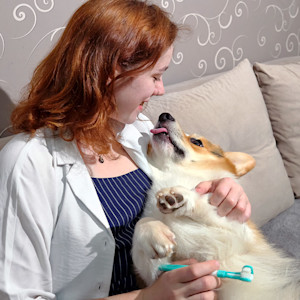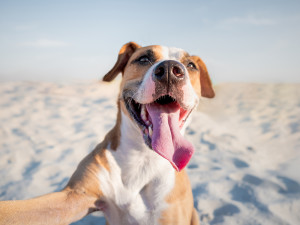Can Dogs Get Braces for Their Teeth?
Find out if your dog can rock some sick neon bands on their teeth like you did in middle school.

Share Article
In This Article:
Why Dogs May Need Braces How to Tell if Your Dog Needs Braces Typical Cost of Dog Braces How Long Do Dogs Need to Wear Braces? How to Care for a Dog With Braces
Just like people, dogs can experience crooked teeth and malocclusions, a condition where the teeth are not perfectly aligned when the mouth is closed. And it’s no joke when your vet suggests that your dog get braces and other orthodontic care.
Although crooked teeth are not always an issue, traumatic malocclusions can cause damage to one or more teeth involved. For instance, teeth can hit the gum or the palate, causing pain each time the dog eats or chews. In severe cases, it also may prevent some dogs from being able to close their mouths fully.
Does your dog have problems chewing or any sort of mouth pain? Find out if your pup needs braces, and how to go about getting them.

Why dogs may need braces for their teeth
Braces are one of a few options that can help move crooked or misaligned teeth into more normal positions. Typically performed by board-certified dentists, various treatment options can help if the teeth are causing pain and trauma to surrounding structures, preventing the dog from eating and chewing normally. A combination of brackets, elastic bands, and wires — similar to human braces — can be used to create a more perfect bite. Additionally, composite extensions can be used to move teeth into more normal positions.
How to tell if your dog needs braces
What conditions do braces for dogs treat?
Braces will realign teeth that are in an abnormal position, causing a dog pain. They can also help with trauma to structures in the mouth, such as the palate, the gums, or other teeth. Not all malocclusions need to be treated with braces.
What is the typical age at which a dog gets braces?
The earlier, the better. Oftentimes, malocclusions will be identified early on, and treatment should be pursued as soon as possible. The teeth of younger dogs, especially adult teeth that have just erupted, are more amenable to movement with orthodontics.
What are the common signs and oral symptoms?
Oftentimes, no clinical signs are observed by the pet parent, and the malocclusion is identified by a veterinarian. In severe cases, you might notice that your dog is not able to close their mouth all the way, or they are having difficulty chewing food.
What are some factors to consider if you’re thinking about braces for your dog?
First of all, you’ll want to consider if this is something that will really improve your dog’s life. If your vet has not recommended braces as the first and best solution, you’ll want to ask:
Is your dog in significant pain, and what does your vet recommend as an alternative solution?
Is your dog able to undergo anesthesia or sedation? Or is it a risk to do so for any reason?
Is this a cost that is covered by your pet insurance? Even if you don’t think so, it’s worth contacting your insurance company.
What is the typical cost of dog braces?
The cost of dog braces can vary based on the treatment itself and where you are located, but it will typically cost $2,000 to $5,000. This will include necessary adjustments as the teeth move, as well as any sedation or anesthesia that’s required.
How long do dogs need to wear braces?
In general, the earlier the issue is addressed, the shorter the time that the dog will need to wear braces. Oftentimes in young dogs, you can see complete resolution of a problem within one to two months — with some pups requiring a shorter or longer course of treatment depending on their age and severity of the malocclusion.
How do I care for my dog when they have braces?
Typically, your dog’s dentist will help plan their care throughout the time they are wearing braces. Many times, nothing different needs to be done at home. But your dog will require frequent follow-ups with the dentist, so making sure that you live close by is an important factor, especially if there’s an issue.
FAQs
Can you fix high canine teeth without braces?
High canines refer to a dental misalignment commonly seen in people (when their canine teeth are positioned too high), which can lead to issues with other teeth and problems chewing or eating. This is treated with braces in people. The specific issue is not common in dogs, who can have malocclusions (improper jaw lengths) or misalignment of individual teeth which leads to similar issues with chewing and eating, or damaging other teeth in the mouth. Treatment can require orthodontics (like braces) or tooth removal to provide the dog with more comfort while eating.
Whom should you see to get a diagnosis and treatment plan for dog braces?
Your primary care veterinarian should be able to make a diagnosis and guide you to the right person. If this is something that needs to be managed by a dentist, they will typically have a list of providers nearby who can help.

Dr. Gabrielle Fadl, DVM
After graduating from Kansas State University College of Veterinary Medicine, Dr. Fadl returned to the New York area to pursue a one-year rotating internship and has been working in general practice since. Dr. Fadl loves working in the pet space to foster the powerful human-animal bond. She hopes to continually learn and grow to practice the best quality medicine. Her motto is “Keep calm and try to take it as it comes.”
Related articles
![Woman holding her Corgi dog in her lap while she brushes it's teeth.]()
Dog Tartar Removal: How to Clean Your Dog’s Teeth
Everything you need to know about dog tarter and dental health.
![Dog in the sand smiling at the camera]()
Can Dogs Smile?
There’s a big difference between a dog smiling and showing their teeth.
![Woman brushing her dog's teeth at home.]()
How Often Should You Brush Your Dog’s Teeth?
Some things you can do to keep those chompers sparkling through their senior years.
![A woman hugging her dog.]()
Want Your Dog to Live Longer?
Seriously, though. The Dog Aging Project is looking for participants.





